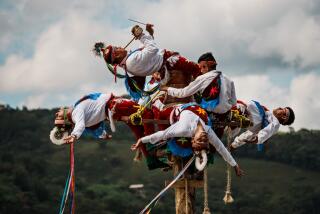Central America
- Share via
Imagine two continents separated by miles of ocean, and yet over millions of years, bits of land emerge and gradually form a bridge to become what we call Central America. Just like the Bering Strait, this important geographic development enabled migration, in this case from North America to South America, and made possible a vibrant mix of cultures, vegetation and wildlife. Explore the beauty and history of Guatemala, Belize, El Salvador, Honduras, Nicaragua, Costa Rica and Panama through these direct links on The Times Launch Point Web site: https://fold6.site./launchpoint
Here are the best sites for getting your schoolwork done or for just having fun.
Level 1
National Geographic: Ancient Mayan Glyphs: Participate in an interactive archeological expedition in which you visit a stone temple in Guatemala. Search for artifacts and stories as you learn about the ancient Mayan civilization.
https://www.nationalgeographic.com/bureau/index.html
Project Central America Basecamp: Read field reports and view photos from three teacher-explorers as they bicycled through all seven countries of Central America.
https://www3.adventureonline.com/basecamp.asp?expeditionid=7
What Is It Like Where You Live: Rain Forests: The tropical rain forests in Central America are home to such plants as chicle, used for chewing gum, and cacao, which was called “the food of the gods” by the Mayans and Aztecs and is used to make chocolate. Visit a rain forest in Tikal, Guatemala, and learn about the importance of this habitat’s diverse plants and animals.
https://mbgnet.mobot.org/sets/rforest/index.htm
Level 2
Central America’s National Parks: Central America contains an estimated 7% of all the world’s species of plants and animals. Take a photo tour of some of its national parks, which include volcanoes, forests, coral reefs and swamps.
https://www.nps.gov/centralamerica/
CNN: Panama Canal Handover: In December 1999, the Panama Canal returned to Panamanian control after nearly 100 years of U.S. involvement. View photos that show the difficult challenges engineers faced in constructing the 50-mile canal and read articles discussing both its history and its future.
https://www.cnn.com/SPECIALS/1999/panama.canal/
Encarta: Central America: Central America is home to a mix of both North American and South American plants and animals. View maps and learn about this region’s geography, economy, people and history.
https://encarta.msn.com/find/Concise.asp?z=1&pg;=2&ti;=761574502
Level 3
Experience Nicaragua: From the ancient Mayan civilization and the Spanish conquistadors to the Sandinista revolution and today’s republic, read about this country’s tumultuous history. Experience its culture through poetry, stories, recipes, photos, interviews and video clips of volcano eruptions and mariachi music. Note: This site is available in English, Spanish and Japanese.
https://library.thinkquest.org/17749/
Library of Congress Country Studies: El Salvador, Guatemala, Honduras, Nicaragua, and Costa Rica once united to form the United Provinces of Central America in 1823 only to disband less than 20 years later because of political turmoil. The Library of Congress has extensive information on the geography, economy, government, culture, politics and history of five Central American countries: Belize, El Salvador, Honduras, Nicaragua, and Panama.
https://lcweb2.loc.gov/frd/cs/cshome.html#toc
Honduras This Week: This online newspaper covers not only business, cultural and national news of Honduras but also the whole Central American region.
https://www.marrder.com/htw/central.htm
Launch Point is produced by the UC Irvine department of education, which reviews each site for appropriateness and quality. Even so, parents should supervise their children’s use of the Internet. This column was designed by Ivan Miranda, Reyna Acosta, Kimberly Erskine and Anna Manring.
EXPLORER’S QUEST
The answer to this Internet quiz can be found in the sites at right.
How many miles can a ship save by using the Panama Canal when sailing from New York to San Francisco?
CLUE: See CNN: Panama Canal Handover
Find What You Need to Know: Have a project on California history? Need help doing a math problem? Launch Point now covers more than 100 topics for getting your schoolwork done. Go to https://fold6.site./launchpoint for the full list of subjects and direct links to the best Internet sites.
Answer to last week’s Quest: Red herrings are false clues that mislead a reader trying to solve a mystery.
More to Read
Sign up for The Wild
We’ll help you find the best places to hike, bike and run, as well as the perfect silent spots for meditation and yoga.
You may occasionally receive promotional content from the Los Angeles Times.






